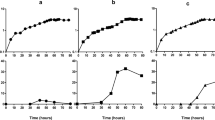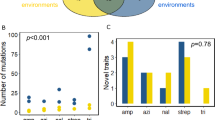Abstract
Mutations can arise in static populations of cells that are subjected to nonlethal selective pressure, a phenomenon that has been called ‘adaptive mutation’. This phenomenon has been extensively studied in FC40, a strain ofEscherichia coli that cannot metabolize lactose (Lac−) but that reverts to lactose utilization (Lac+) when lactose is its sole energy and carbon source. The adaptive Lac+ mutations arise by two mutational processes: a recombination-dependent process that is highly active on the episome carrying the Lac− allele, and an unknown process that affects the whole genome. Most of the Lac+ mutations are due to the first process, which also produces nonselected mutations on the F′ episome. However, about 10% of the Lac+ mutations arise in a subpopulation of cells that experience a period of transient hypermutation. Although minor contributors to any one type of mutation, the hypermutators account for nearly all cases of multiple mutations. The evolutionary implications of these results are: (i) DNA synthesis associated with recombination may be an important source of spontaneous mutation, particularly in cells that are not actively growing; (ii) the efficient mutational mechanism that occurs on the episome could result in the horizontal transfer of new alleles among species that carry and exchange conjugal plasmids; and (iii) a subpopulation of transient hypermutators could be a source of multiple mutations that would allow for rapid adaptive evolution under adverse conditions.
Similar content being viewed by others
References
Andersson D. I., Slechta E. S. and Roth J. R. 1998 Evidence that gene amplification underlies adaptive mutability of the bacteriallac operon.Science 282, 1133–1135.
Boe L. 1990 Mechanism for induction of adaptive mutations inEscherichia coli.Mol. Microbiol. 4, 597–601.
Boyd E. F. and Hartl D. L. 1997 Recent horizontal transmission of plasmids between natural populations ofEscherichia coli andSalmonella enterica.J. Bacteriol. 179, 1622–1627.
Boyd E. F., Hill C. S., Rich S. M. and Hartl D. L. 1996 Mosaic structure of plasmids from natural populations ofEscherichia coli.Genetics 143, 1091–1100.
Cairns J. 1998 Mutation and cancer: The antecedents to our studies of adaptive mutation.Genetics 148, 1433–1440.
Cairns J. and Foster P. L. 1991 Adaptive reversion of a frameshift mutation inEscherichia coli.Genetics 128, 695–701.
Cairns J., Overbaugh J. and Miller S. 1988 The origin of mutants.Nature 335, 142–145.
Calos M. P. and Miller J. H. 1981 Genetic and sequence analysis of frameshift mutations induced by ICR-191.J. Mol. Biol. 153, 39–66.
Carter J. R., Patel D. R. and Porter R. D. 1992 The role oforiT intra-dependent enhanced recombination between mini-F-lac-oriT and lambdaplac5.Genet. Res. 59, 157–165.
Christensen R. B., Christensen J. R. and Lawrence C. W. 1985 Conjugation-dependent enhancement of induced and spontaneous mutation in thelacI gene ofE. coli.Mol. Gen. Genet. 201, 35–37.
Demerec M. 1963 Selfer mutants ofSalmonella typhimurium.Genetics 48, 1519–1531.
Escarceller M., Hicks J., Gudmundsson G., Trump G., Touati D., Lovett S., Foster P. L., McEntee K. and Goodman M. F. 1994 Involvement ofEscherichia coli DNA polymerase II in response to oxidative damage and adaptive mutation.J. Bacteriol. 176, 6221–6228.
Firth N., Ippen-Ihler K. and Skurray R. A. 1996 Structure and function of the F factor and mechanism of conjugation. InEscherichia coli and Salmonella: cellular and molecular biology (ed. F. C. Neidhardt, R. Curtiss III, J. L. Ingraham, E. C. C. Lin, K. B. Low, B. Magasanik, W. S. Reznikoff, M. Riley, M. Schaechter and H. E. Umbarger), pp. 2377–2412. American Society of Microbiology, Washington, DC.
Foster P. L. 1993 Adaptive mutation: The uses of adversity.Annu. Rev. Microbiol. 47, 467–504.
Foster P. L. 1994 Population dynamics of a Lac− strain ofEscherichia coli during selection for lactose utilization.Genetics 138, 253–261.
Foster P. L. 1997 Nonadaptive mutations occur on the F′ episome during adaptive mutation conditions inEscherichia coli.J Bacteriol. 179, 1550–1554.
Foster P. L. 1999 Are adaptive mutations due to a decline in mismatch repair? The evidence is lacking.Mutat. Res. 436, 179–184.
Foster P. L. and Cairns J. 1992 Mechanisms of directed mutation.Genetics 131, 783–789.
Foster P. L. and Rosche W. A. 1999 Increased episomal replication accounts for the high rate of adaptive mutation inrecD mutants ofEscherichia coli.Genetics 152, 15–30.
Foster P. L. and Trimarchi J. M. 1994 Adaptive reversion of a frameshift mutation inEscherichia coli by simple base deletions in homopolymeric runs.Science 265, 407–409.
Foster P. L. and Trimarchi J. M. 1995a Adaptive reversion of an episomal frameshift mutation inEscherichia coli requires conjugal functions but not actual conjugation.Proc. Natl. Acad. Sci. USA 92, 5487–5490.
Foster P. L. and Trimarchi J. M. 1995b Conjugation is not required for adaptive reversion of an episomal frameshift mutation inEscherichia coli.J. Bacteriol. 177, 6670–6671.
Foster P. L., Gudmundsson G., Trimarchi J. M., Cai H. and Goodman M. F. 1995 Proofreading-defective DNA polymerase II increases adaptive mutation inEscherichia coli.Proc. Natl. Acad. Sci. USA 92, 7951–7955.
Foster P. L., Trimarchi J. M. and Maurer R. A. 1996 Two enzymes, both of which process recombination intermediates, have opposite effects on adaptive mutation inEscherichia coli.Genetics 142, 25–37.
Frost L. S. and Manchak J. 1998 F− phenocopies: characterization of expression of the F transfer region in stationary phase.Microbiology 144, 2579–2587.
Galitski T. and Roth J. R. 1995 Evidence that F plasmid transfer replication underlies apparent adaptive mutation.Science 268, 421–423.
Hall B. G. 1990 Spontaneous point mutations that occur more often when they are advantageous than when they are neutral.Genetics 126, 5–16.
Harris R. S., Longerich S. and Rosenberg S. M. 1994 Recombination in adaptive mutation.Science 264, 258–260.
Harris R. S., Ross K. J. and Rosenberg S. M. 1996 Opposing roles of the Holliday junction processing systems ofEscherichia coli in recombination-dependent adaptive mutation.Genetics 142, 681–691.
Harris R. S., Bull H. J. and Rosenberg S. M. 1997a A direct role for DNA polymerase III in adaptive reversion of a frameshift mutation inEscherichia coli.Mutat. Res. 375, 19–25.
Harris R. S., Feng G., Ross K. J., Sidhu R., Thulin C., Longerich S., Szigety S. K., Winkler M. E. and Rosenberg S. M. 1997b Mismatch repair protein MutL becomes limiting during stationary-phase mutation.Genes Dev. 11, 2426–2437.
Holloway B. and Low K. B. 1996 F-prime and R-prime factors. InEscherichia coli and Salmonella: cellular and molecular biology (ed. F. C. Neidhardt, R. Curtiss III, J. L. Ingraham, E. C. C. Lin, K. B. Low, B. Magasanik, W. S. Reznikoff, M. Riley, M. Schaechter and H. E. Umbarger), pp. 2413–2420. American Society of Microbiology, Washington, DC.
Kogoma T. 1997 Stable DNA replication: interplay between DNA replication, homologous recombination, and transcription.Microbiol. Mol. Biol. Rev. 61, 212–238.
Kowalczykowski S. D., Dixon D. A., Eggleston A. K., Lauder S. C. and Rehrauer W. M. 1994 Biochemistry of homologous recombination inEscherichia coli.Microbiol. Rev. 58, 401–465.
Kunz B. A. and Glickman B. W. 1983 The infidelity of conjugal DNA transfer inEscherichia coli.Genetics 105, 489–500.
Kuzminov A. 1995 Collapse and repair of replication forks inEscherichia coli.Mol. Microbiol. 16, 373–384.
Marians K. J., Hiasa H., Kim D. R. and McHenry C. S. 1998 Role of the core DNA polymerase III subunits at the replication fork;α is the only subunit required for processive replication.J. Biol. Chem. 273, 2452–2457.
Miller J. H. 1985 Mutagenic specificity of ultraviolet light.J. Mol. Biol. 182, 45–65.
Modrich P. and Lahue R. 1996 Mismatch repair in replication fidelity, genetic recombination, and cancer biology.Annu. Rev. Biochem. 65, 101–133.
Ninio J. 1991 Transient mutators: A semiquantitative analysis of the influence of translation and transcription errors on mutation rates.Genetics 129, 957–962.
Radicella J. P., Park P. U. and Fox M. S. 1995 Adaptive mutation inEscherichia coli: A role for conjugation.Science 268, 418–420.
Rangarajan S., Gudmundsson G., Qiu Z., Foster P. L. and Goodman M. F. 1997Escherichia coli DNA polymerase II catalyzes chromosomal and episomal DNA synthesisin vivo.Proc. Natl. Acad. Sci. USA 94, 946–951.
Rosche W. A. and Foster P. L. 1999 The role of transient hypermutators in adaptive mutation inEscherichia coli. Proc. Natl. Acad. Sci. USA 96 (in press).
Rosenberg S. M., Longerich S., Gee P. and Harris R. S. 1994 Adaptive mutation by deletions in small mononucleotide repeats.Science 265, 405–407.
Roth J. R., Benson N., Galitski T., Haack K., Lawrence J. G. and Miesel L. 1996 Rearrangements of the bacterial chromosome: formation and applications. InEscherichia coli and Salmonella: cellular and molecular biology (ed. F. C. Neidhardt, R. Curtiss III, J. L. Ingraham, E. C. C. Lin, K. B. Low, B. Magasanik, W. S. Reznikoff, M. Riley, M. Schaechter and H. E. Umbarger), pp. 2256–2276. American Society of Microbiology, Washington, DC.
Stahl F. W. 1988 A unicorn in the garden.Nature 335, 112–113.
Strathern J. N., Shafer B. K. and McGill C. B. 1995 DNA synthesis errors associated with double-strand-break repair.Genetics 140, 965–972.
Tlsty D. T., Albertini A. M. and Miller J. H. 1984 Gene amplification in thelac region ofE. coli.Cell 37, 217–224.
Torkelson J., Harris R. S., Lombardo M.-J., Nagendran J., Thulin C. and Rosenberg S. M. 1997 Genome-wide hypermutation in a subpopulation of stationary-phase cells underlies recombination-dependent adaptive mutation.EMBO J. 16, 3303–3311.
West S. C. 1996 The RuvABC proteins and Holliday junction processing inEscherichia coli.J. Bacteriol. 178, 1237–1241.
Author information
Authors and Affiliations
Corresponding author
Rights and permissions
About this article
Cite this article
Foster, P.L., Rosche, W.A. Adaptive mutation inEscherichia coli strain FC40. J Genet 78, 7–11 (1999). https://doi.org/10.1007/BF02994697
Issue Date:
DOI: https://doi.org/10.1007/BF02994697




